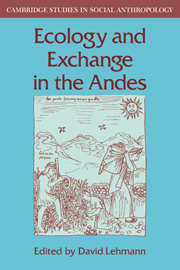Book contents
- Frontmatter
- Contents
- List of contributors
- Acknowledgements
- The Andean region: relief
- The Andrean region showing ecological levels (after Troll 1968)
- 1 Introduction: Andean societies and the theory of peasant economy
- 2 The role of the Andean ayllu in the reproduction of the petty commodity regime in Northern Potosí (Bolivia)
- 3 Labour and produce in an ethnic economy, Northern Potosi, Bolivia
- 4 ‘Resistance to capitalism’ in the Peruvian Andes
- 5 Production and market exchange in peasant economies: the case of the southern highlands in Peru
- 6 The Andean economic system and capitalism
- 7 Property and ideology: a regional oligarchy in the Central Andes in the nineteenth century
- 8 Multi-levelled Andean society and market exchange: the case of Yucay (Peru)
- Glossary
- References
- Index
- Cambridge Studies in Social Anthropology
8 - Multi-levelled Andean society and market exchange: the case of Yucay (Peru)
Published online by Cambridge University Press: 29 September 2009
- Frontmatter
- Contents
- List of contributors
- Acknowledgements
- The Andean region: relief
- The Andrean region showing ecological levels (after Troll 1968)
- 1 Introduction: Andean societies and the theory of peasant economy
- 2 The role of the Andean ayllu in the reproduction of the petty commodity regime in Northern Potosí (Bolivia)
- 3 Labour and produce in an ethnic economy, Northern Potosi, Bolivia
- 4 ‘Resistance to capitalism’ in the Peruvian Andes
- 5 Production and market exchange in peasant economies: the case of the southern highlands in Peru
- 6 The Andean economic system and capitalism
- 7 Property and ideology: a regional oligarchy in the Central Andes in the nineteenth century
- 8 Multi-levelled Andean society and market exchange: the case of Yucay (Peru)
- Glossary
- References
- Index
- Cambridge Studies in Social Anthropology
Summary
Introduction
In seeking to define the specific characteristics of Andean society and economy J.V. Murra has developed the concept of a system of vertical production (Murra 1972a). In this region the desert coasts, interrupted occasionally by oases, contrast strikingly with the quechua region and its fertile valleys (at 3000–3500 metres), with the high plateaux and their puna vegetation (above 4000 metres), and with the subtropical forest of the Amazonian side of the mountains.
Murra shows how a nucleus of settlement controlled resources on several ‘floors’ or ‘niches’ through the establishment of colonies at varying distances. Settlers in peripheral colonies kept their houses and all their rights in their communities of origin. The colonies could be shared with other ethnic groups from other nuclei who were establishing outposts on the same pattern.
In his analysis of this vertical economic system, Murra draws on numerous examples taken for the most part from a detailed analysis of the visitas, inquiries carried out on the spot by the Spanish colonial administration whose wealth of information is revealed by Murra's work. Thus the central nucleus of the ‘archipelago’ of Chupaychu people in the region of Huanuco was about one day's walk away from both corn fields situated at a lower altitude and potato fields higher up.
- Type
- Chapter
- Information
- Ecology and Exchange in the Andes , pp. 211 - 230Publisher: Cambridge University PressPrint publication year: 1982
- 4
- Cited by



